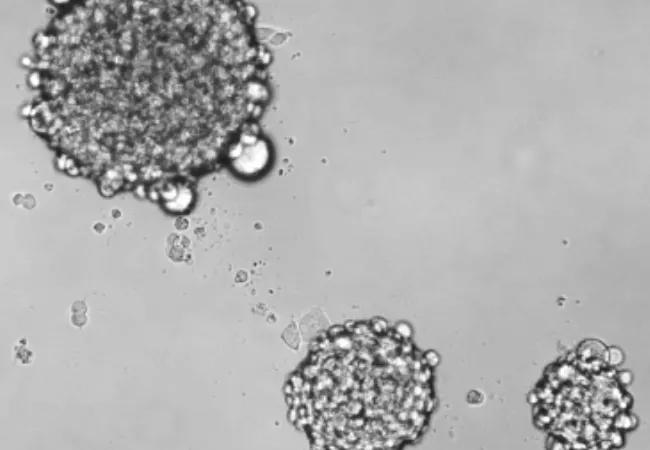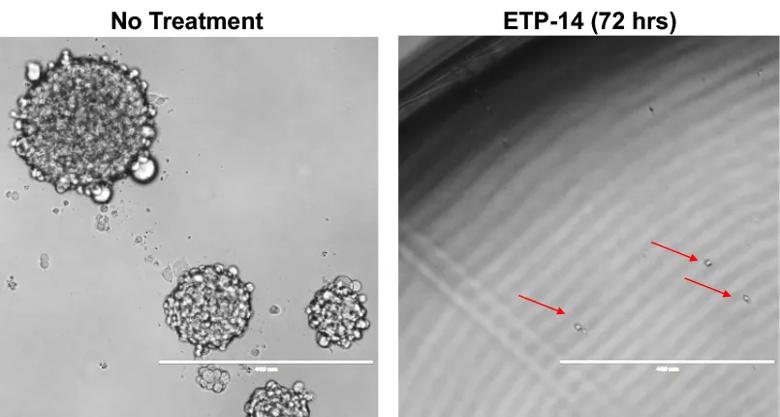Advertisement
An array of investigations underway at Cleveland Clinic

If there ever was a condition that demanded novel research approaches, it is pediatric high-grade glioma (HGG) — the most lethal type of brain tumor in children.
Advertisement
Cleveland Clinic is a non-profit academic medical center. Advertising on our site helps support our mission. We do not endorse non-Cleveland Clinic products or services. Policy
“It’s heartbreaking to diagnose a child with a high-grade glioma, because a cure is unlikely with current treatments,” says Violette Recinos, MD, Section Head of Pediatric Neurosurgical Oncology at Cleveland Clinic. She notes that despite surgery, radiation and chemotherapy, HGG usually recurs within two to three years and is almost always ultimately fatal.
That dismal prognosis is why Cleveland Clinic’s Pediatric Brain Tumor Research Program is pursuing an array of investigations focused on a promising research area — epigenetic regulation — as a possible treatment avenue for HGG, says Dr. Recinos, who is leading the research efforts.
Epigenetic targeting is an evolving avenue of research focused on understanding how gene expression is regulated. Identifying tumor-specific epigenetic inhibitors holds the promise of enabling development of novel drugs that can stop cancer cell proliferation and invasiveness while leaving healthy cells unaffected.
“With advancing genetic and epigenetic technologies, we better understand the underlying mechanisms that may contribute to the aggressive nature of HGGs or their therapeutic resistance,” explains Stephen Dombrowski, PhD, a research scientist in Cleveland Clinic’s Rose Ella Burkhardt Brain Tumor and Neuro-Oncology Center who serves as translational lead in the pediatric HGG investigations. “This opens the door for developing very specific, targeted therapies against cancers.”
With the assistance of multiple funding sources, Drs. Recinos and Dombrowski are currently leading several noteworthy avenues of research, as outlined below.
Epigenetic targeting of pediatric HGGs with H3 K27M mutation. About 70 percent of HGGs (which include glioblastoma, anaplastic astrocytoma and diffuse intrinsic pontine glioma) have a specific genetic mutation known as H3 K27M; its presence indicates a particularly poor prognosis, as it encodes for histone variants thought to be the drivers of glioma growth. Ongoing investigations by Cleveland Clinic’s Pediatric Brain Tumor Research Laboratory aim to identify epigenetic inhibitors that specifically alter the aberrant regulatory mechanisms associated with this mutation.
Preliminary findings indicate that inhibitors of histone deacetylase (HDAC) and histone lysine methyltransferase (HMT) selectively kill pediatric HGG tumor cells. These compounds are actively being investigated as candidate drugs.
Inhibiting HMT with novel epipolythiodioxopiperazine (ETP) alkaloids. One class of HMT inhibitors with potent anticancer activity consists of complex compounds known as ETP alkaloids. These highly potent and novel compounds (see Figure for the effects of one example), which were obtained through collaboration with Mohammed Movassaghi, PhD, a medicinal chemist at the Massachusetts Institute of Technology, are currently being tested in the lab against pediatric HGGs that harbor the H3 K27M and other mutations.
Advertisement

Figure. Photomicrographic images showing tumor cells that are untreated (left) and treated with drug ETP-14 (right). Untreated cells form large, multicellular tumor spheres, in contrast to ETP-14-treated cultures, which remain as a few single cells (arrows) without the capacity to form spheres. Scale bars = 400 µm.
Improving radiotherapy with novel epigenetic targeting. Evidence indicates that epigenetic compounds might not only kill pediatric HGG cells but also increase the cytotoxic effects of radiation therapy. Preliminary findings by the Pediatric Brain Tumor Research Lab show that specific HDAC inhibitors may have a synergistic effect when combined with conventional (single-fraction, low-dose) radiotherapy.
“Most patients will undergo surgery and chemotherapy/radiotherapy as standard of care, so new compounds should be tested after exposure to those treatments rather than de novo,” Dr. Dombrowski explains. “New drugs have a better chance of being considered and tested if they work synergistically with existing therapies, including existing drug therapies.”
Identifying and targeting cancer stem cells in pediatric HGG. Cancer stem cells are a small subpopulation of pluripotent cells within each tumor that are thought to be responsible for tumorigenesis. These cells are inherently resistant to current radiation and chemotherapy treatments, and they survive “smarter” as a recurring tumor — i.e., adapted to their new environment and resistant to available therapies. The Pediatric Brain Tumor Research Lab is applying cutting-edge techniques to isolate cancer stem cells from other cells in pediatric HGG and characterize them so they can be specifically targeted with epigenetic therapeutics.
Advertisement
Dr. Dombrowski attributes the strength of the Pediatric Brain Tumor Research Program to its continuous interactions among clinicians and basic science researchers, which keep the investigations clinically relevant and translate to greater impact on patient care. He notes that the availability of experts in cancer biology, genetics and biomedical engineering at Cleveland Clinic is another enormous asset.
Dr. Recinos adds that the pediatric brain tumor research community at large is a collaborative one, to everyone’s benefit. Sharing of cell lines, xenografts and human specimens of rare tumors among Cleveland Clinic and multiple U.S. and international institutions has proven invaluable for everyone involved, she says.
“Our lab now has more than 50 pediatric brain tumor specimens, nearly half of which were obtained through collaboration,” she notes. “This has greatly advanced our program’s ability to characterize genetic and molecular signatures and provide a platform for drug discovery.”
Although every group has a different focus, Dr. Recinos expects that the pediatric brain tumor research community will move forward together, as cellular mechanisms of various cancers may prove similar. She anticipates that novel epigenetic drugs will be tested for specific cancers within the next decade — and that once that occurs, the process will be accelerated for testing other cancers with the same targets.
Advertisement
Advertisement

Polygenic risk score could help predict who will develop this aggressive breast cancer

New guidelines offer insight into emerging therapies, dental issues and more

Clinical trial to assess the value of nutritional, physical therapy and social supports prior to preoperative chemotherapy

Research demonstrates improved overall survival for patients receiving comprehensive treatment for breast cancer in addition to radiation or surgical intervention for brain cancer

Platinum-eligible phase 3 trial of enfortumab vedotin and pembrolizumab yields ‘unprecedented data’

Cleveland Clinic Cancer Institute brings multidisciplinary care, precision oncology and clinical research to the United Arab Emirates

Extent of baseline burden impacts progression-free and overall survival

Further study warranted to better understand the clinical implications of these findings